Since we keep perishable food cold in an ice chest on the road, having a portable ice maker to make ice in-truck seemed like a good alternative to constantly buying ice at a truck stop or from ice vending machines.
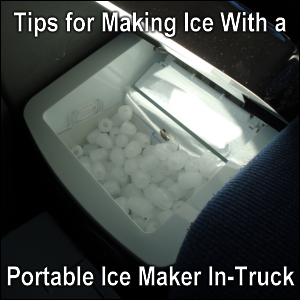 When a driver uses ice for food preservation and to cool drinks, he/she can run through it pretty quickly.
When a driver uses ice for food preservation and to cool drinks, he/she can run through it pretty quickly.
During warm and hot months, ice melts off more quickly (unless the temperature inside one’s tractor can be continually kept stable).
During November 2009, we went through $60 of truckstop-purchased ice — very expensive!
Vicki researched portable ice makers with a view toward having one in the truck Mike drove regionally.
Her rationale was that — at the $60 per month spending rate to buy ice — it would take only five months to pay for a top-rated machine with a multi-year warranty.
After five months’ worth of usage, the portable ice maker would have paid for itself!
Her research led her to Air-n-Water.com’s NewAir Ai200-SS.(1)
It is similar to the machine shown here from Amazon.com, with which we have an affiliate relationship.
So, we ordered one.
Granted, for a portable ice maker it is a large machine:
- weighing 46 pounds and
- having dimensions of 16″ (L) x 14″ (D) x 16″ (H).
When Mike dug it out of the box, we wondered if Vicki had measured the intended space correctly.
Fortunately, it fit (albeit barely and sideways) between the dash and the passenger seat, as shown here.
The Freightliner Cascadia that Mike was driving when this photo was taken had seat bottoms that could be pulled out (which is good for drivers with long legs).
In order to open the lid, the passenger seat has to be pushed in.
How This Portable Ice Maker Makes Ice
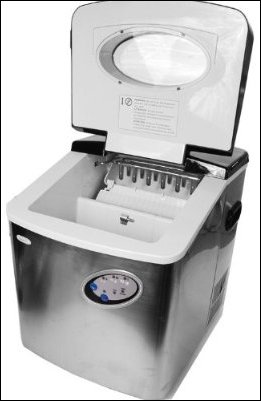 In a nutshell, ice is formed when metal “fingers” are lowered into a trough of water and cooled.
In a nutshell, ice is formed when metal “fingers” are lowered into a trough of water and cooled.
The ice forms around and under the fingers.
When the freezing cycle is completed,
- the trough of water swings back (dumping out the water),
- the fingers warm slightly to “release” the ice, and
- a slide attached to the front of the trough scoops up the ice and dumps it over the edge into the basket (which sits directly above the water reservoir).
It is interesting to watch the ice making process on this portable ice maker.
The Shape of the Ice
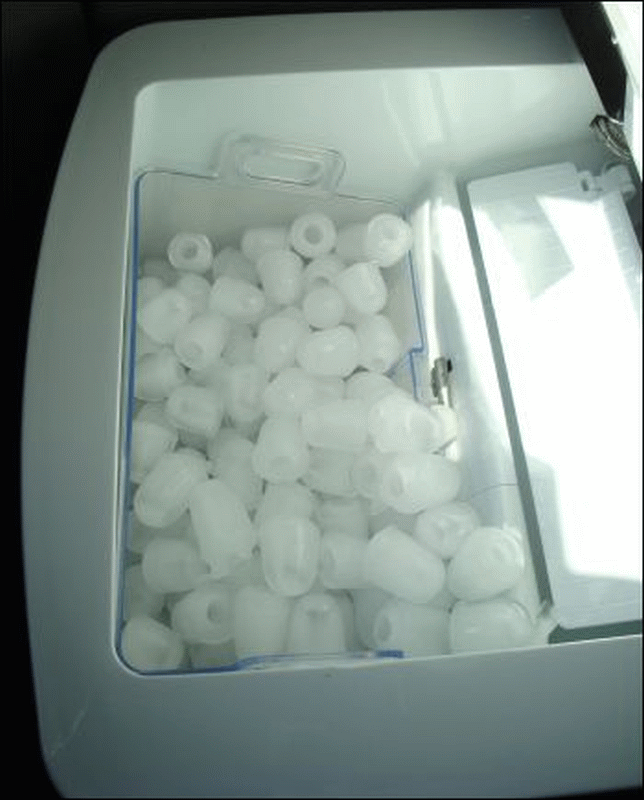
In this photo, you see how this portable ice maker has made a full basket of “mushroom cap” shaped pieces of ice (what we’ll call “ice caps” instead of “ice cubes”).
The ice forming process will stop when the metal sensor behind the basket senses the basket is full.
The unit is capable of making small, medium or large ice caps.
Based on our experience:
– small caps take about 9 minutes to make;
– medium caps take about 11 minutes to make; and
– large caps take about 13 minutes to make.
However, the small and medium sized caps melt more quickly than the large sized caps, so we prefer to make the large ones.
The water reservoir has a one-gallon sized capacity.
We haven’t yet figured out how many baskets full of ice caps we can make from a gallon of water.
However, the unit will let you know when:
– the basket is full of ice or
– the reservoir is out of enough water to make another batch of ice.
Variations in Batch of Ice
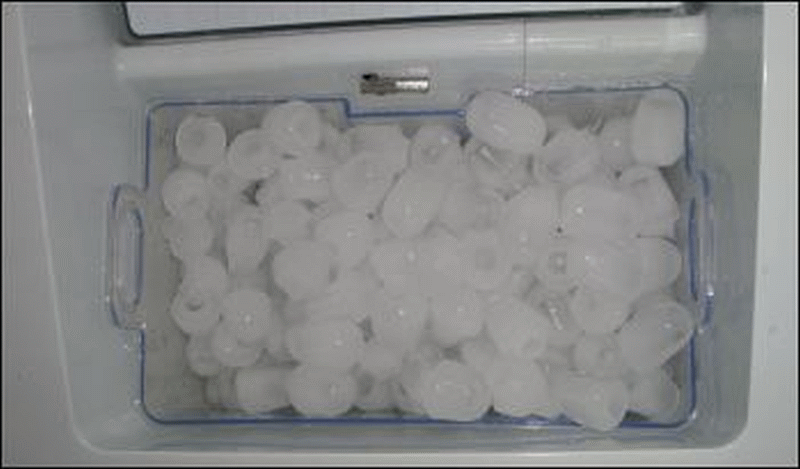 If you look closely at this photo, you will see varying sizes of ice caps, not only in thickness but in length.
If you look closely at this photo, you will see varying sizes of ice caps, not only in thickness but in length.
The length of the caps is based on the amount of water in the tray, which can slosh out in transit.
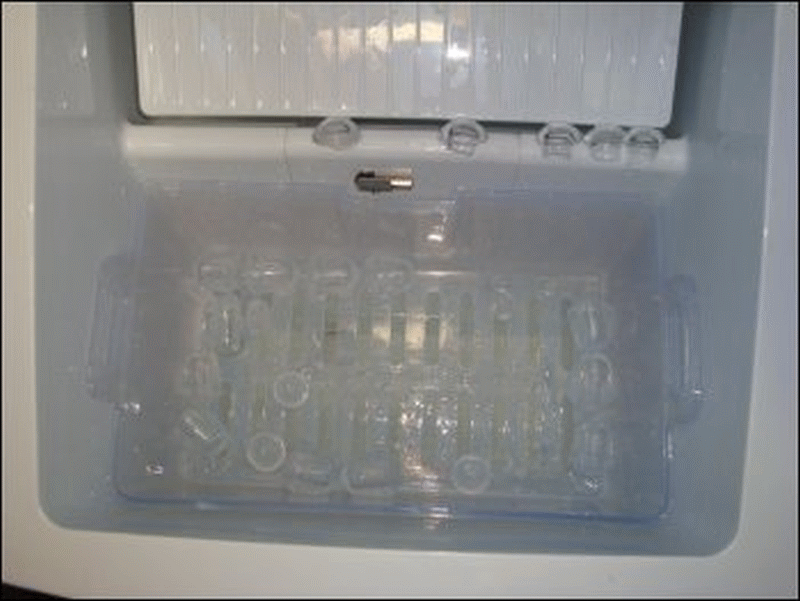 This photo shows some extremely small ice caps, as if the ice-forming process was interrupted.
This photo shows some extremely small ice caps, as if the ice-forming process was interrupted.
However, the cycle wasn’t interrupted. The caps that formed here went through a full ice-forming cycle.

This is a close-up view of the very small ice caps.
We determined that these formed when it was very warm in the truck.
The portable ice maker did its best to generate ice but at times had difficulty.
This size ice is the exception, not the rule.
Below, we’ll summarize our experience with this machine.
Pros
When we ordered the NewAir Ai200-SS with a 5-year extended warranty on December 10, 2009, we commented, “We look forward to giving a good review of this product on our travel-related website.”
Air-n-Water has honored its warranty most admirably.
We returned one portable ice maker because it was inconsistent in making ice and started to “clink” inside.
We returned a second one for what we considered a “clog” of particulate matter inside the machine which we could not flush out (see “Cons” under the filter).
The third machine (with our additional secondary filter) has worked extremely well in-truck and even in our home.
As long as
- there is sufficient water in the reservoir,
- the basket is not full,
- there is a power source strong enough to operate it, and
- there are no other hindrances,
this portable ice maker has made 12 ice caps at a time for us in the size we desire.
The machine — when purchased from the manufacturer — comes with a variety of warranty periods, all the way up to 5 years!
This is an indication of a very well made product.
(Note: If the product is purchased from a reseller like Amazon, an extended warranty period may not be available.)
Cons
The “full basket sensor” on this machine is not 100% foolproof.
It has been known to indicate that the basket is full when it is no where near that point.
As long as the full basket sensor light is on, the machine will not make more ice.
While you can “reset” the machine, we found that by putting our fingers over the sensor, we can warm it up a little to the point where the light goes out and the machine starts making ice again.
The ice caps formed when the surrounding temperature is warm can be quite small, but this is the exception and not the rule.
The “filter” is a small thimble-shaped insert that fits in the hole between the water reservoir and the trough.
The holes in the filter are not small enough to catch small particulate matter (such as you might encounter in an 18-wheel tractor trailer).
No matter how “clean” we thought our water was, evidently there was always some particulate matter that accumulated in the reservoir.
To overcome this, we learned to remove the filter, put a small piece of clean cloth (like a 1.5″ by 1.5″ piece of handkerchief) behind it and reinsert it in the hole.
The cloth acts as a secondary filter, which we replaced weekly.
We learned that when the size of the ice generated by the portable ice maker becomes smaller, this is an indication that the secondary filter
- is clogged with particulate matter and
- prevents water from getting into the trough.
Lack of a secondary filter and presence of small particulate matter of any kind in the water can lead to clogging up of the internal mechanism in the unit.
To the best of our knowledge, there is no way to reverse flush the particulate matter out.
The owner’s manual does not address this.
Cost Savings
Since a gallon of water weighs about 8.35 pounds, then the ice that is generated from one gallon of water would weigh the same (a little more than an 8-pound bag of ice).
A 10-pound bag of ice would require about 1.2 gallons of water.
Let’s calculate some numbers to see any potential savings of making your own ice in a portable ice maker in your truck versus buying it in a truck stop.
(Note: numbers have been figured to two decimal places. Rounding errors may cause a penny difference in some cases.)
| Pounds of ice | Gallons of water required | Cost of pounds of ice at $0.37 per gallon (price of water refill at Wal-Mart) | Cost of pounds of ice at $0.78 per gallon (price of gallon water at Wal-Mart) | Cost of pounds of ice at $1.50 per gallon (truck stop water price) | Pro-rated cost based on 10-pound bagged ice at truckstop ($1.99) |
|---|---|---|---|---|---|
| Calculation | = pounds of ice / 8.35 pounds per gallon (yields gallons) | = gallons * $0.37 (yields cost to make pounds of ice at $0.37 per gallon) | = gallons * $0.78 (yields cost to make pounds of ice at $0.78 per gallon) | = gallons * $1.50 (yields cost to make pounds of ice at $1.50 per gallon) | = (1.99/10) * pounds of ice |
| 8 | 0.96 | $0.35 | $0.75 | $1.44 | $1.59 |
| 10 | 1.20 | $0.44 | $0.93 | $1.80 | $1.99 |
| 16 | 1.92 | $0.71 | $1.49 | $2.88 | $3.18 |
| 20 | 2.40 | $0.89 | $1.87 | $3.60 | $3.98 |
 Not counting the cost of the portable ice maker or the electricity to run it, even if you were to use the most expensive per-gallon water we’ve seen for sale at a truck stop, you would still come out ahead financially by making your own ice over buying 10 pounds of ice for $1.99 at a truck stop!
Not counting the cost of the portable ice maker or the electricity to run it, even if you were to use the most expensive per-gallon water we’ve seen for sale at a truck stop, you would still come out ahead financially by making your own ice over buying 10 pounds of ice for $1.99 at a truck stop!
Your costs can drop dramatically if you buy less expensive water and your costs shrivel to next to nothing if you can get your water for free.
There is a cost (even if just in labor) in procuring enough water to keep the portable ice maker making ice.
There is the issue of where to store the water in your truck.
Many modern trucks have plenty of storage space in lower cabinets or under the lower bunk.
There is another issue of how the weight of the water you carry may require you to take slightly lighter loads.
If your company does not require you to max out the weight on your truck regularly, this may not be a problem for you.
Surprise, Surprise!
Once when we were at the headquarters of Mike’s trucking company, he got to bragging about the portable ice maker in his truck.
There were three other drivers sitting around, all of whom were owner operators.
Knowing the size of most ice makers, all of them were skeptical that a professional truck driver could actually make ice in his truck.
One of the veterans of the road with 33 years of commercial driving experience saw the machine in Mike’s truck and exclaimed, “Now I have seen everything!”
He said that he would leave it to us to come up with an ice-making solution like this.
Requirements
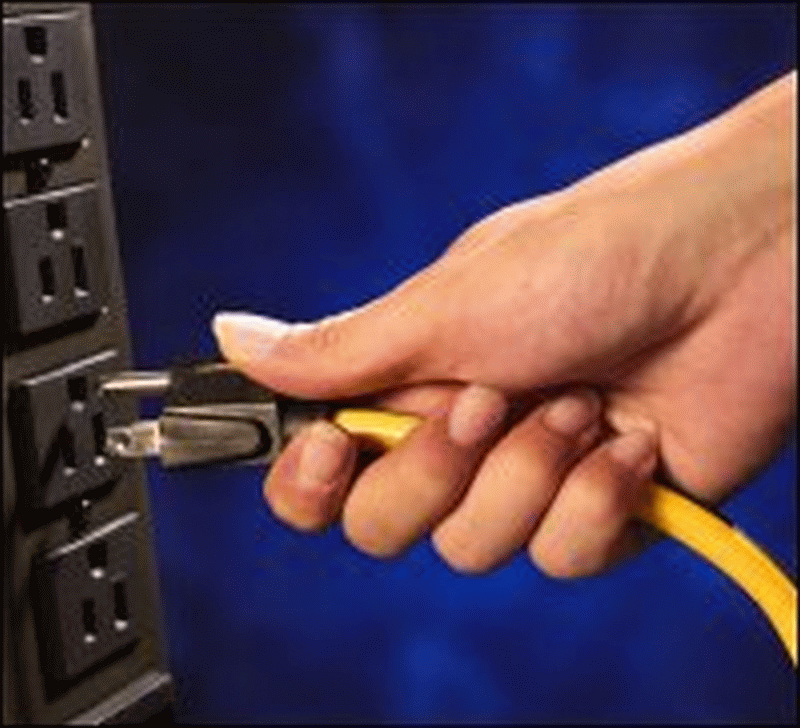 Making ice in your truck will require a constant flow of AC electricity.
Making ice in your truck will require a constant flow of AC electricity.
This portable ice maker takes only 400 watts of power to generate ice.
We used a 1500 watt battery-connected inverter in our truck.
When the ice maker is on, there is still plenty of “juice” for other appliances such as a laptop computer, cell phone recharger, and crock pot to run on.
With this set-up, you can make ice while you are rolling down the road.
However, if you are in a “no idle” area or your company has idling restrictions, you may not be able to make ice in your truck while parked unless you have an installed APU.
Limitations
This machine took up the entire amount of room in front of the passenger seat on the floor in our truck.
If this is where you put the machine in your truck and if you have a passenger in your truck, he/she will not be able to sit in a normal position with his/her feet on the floor.
He/she will have to sit with legs
- crisscrossed in the seat,
- pulled up on top of the unit (which could scratch the top) or
- extended to rest on the dash (the latter of which was Vicki’s favorite position to sit in while working on the laptop).
Of course, you may choose to put your portable ice maker somewhere else in your truck, but remember that you’ll need to open the top to put in water and take out ice based on your ice-making schedule.
Output and Other Considerations
This machine can generate up to 35 pounds of ice per day.
The ice basket has a capacity of about 2.5 pounds.
We figured that it took about 2-to-2.5 hours for the basket to fill.
When the basket fills with ice, you can either move the ice to your cooler or let it sit.
If the ice sits long enough in the basket, it will melt back into the reservoir below.
For most efficient work, you will want to take regular rest breaks to empty the basket whenever the full ice basket sensor light comes on.
If you cannot stop (even for a suggested stretch break) every 2-to-2.5 hours, having a portable ice maker may not work for you.
If you have a full-time passenger with you, you may assign him/her to monitor the machine for ice and water levels.
If the basket holds a maximum of about 2.5 pounds of ice and fills about every 2 hours, you can figure how much time it will take to make the ice you need and how long that will take.
We generally needed only 10-to-20 pounds of ice per day. At that rate:
| 10 pounds per day | 20 pounds per day | 30 pounds per day | |
| 2.5 pounds per basket | 4 basket dumps | 8 basket dumps | 12 basket dumps |
| 2 hours per dump | 8 hours needed | 16 hours needed | 24 hours needed |
The see-through lid allows you to see how much ice is in the basket.
However, the level of ice is not viewable from an angle (like from the driver’s seat if the ice maker is in front of the passenger seat).
That’s the beauty of having the full basket sensor which (if the front of the machine is toward the driver) you will be able to see from the driver’s seat.
Advanced Planning
If you are shut down (such as during the winter due to bad weather), you may not be able to get to a truckstop or grocery store to buy ice.
(One example is if you are on a road that gets closed down due to heavy snowfall.)
You may get tired of scooping snow (assuming there is enough available clean snow) into your ice chest.
Plan ahead.
Additional Help
To help reduce the amount of jarring that the portable ice maker receives while we roll down the road — and to elevate the machine off the floor of the truck (where it can be warm and hinder the ice making process) — we flattened the four gray foam inserts that cushioned the machine’s box inside the packing box and placed them under the four corners of the machine on the floor.
The worse your truck’s front end alignment is, the more your machine will rattle.
Of course, it is best for your truck and your tires to have a proper front end alignment at all times.
If you can get your ice for less (or for free), there is no sense in making your own — unless it melts off too quickly.
We ran into this situation with the ice maker at the Chester, Virginia, terminal of Mike’s trucking company.
The ice from the commercial ice machine there melted off way too fast.
The ice made in our portable ice maker lasted longer because of the caps’ configuration.
Compare the theoretical configurations of ice cubes illustrated below.
Obviously, the one on the left will melt off fastest, the middle one not as fast and the one on the right the slowest of all.
 |
 |
 |
While some commercial ice machines crank out a lot of ice quickly, the configuration of the ice cubes determines the speed at which they will melt.
Also, some machine-produced ice may be just at the freezing point and ready to melt while other machine-produced ice may be at lower temperatures and stay frozen longer.
It is in your best interest to get or make ice that will minimize the amount of work you have to do (time expended) versus the cost (money expended).
This can be explained in part through the tasks involved.
| Get water for ice maker | Put water into ice maker | Machine makes ice | Put ice in ice chest | Ice melts in ice chest | Drain water (melted ice) off ice chest | |
| Bagged ice | No | No | No wait | Yes | Yes | Yes |
| Portable ice maker ice | Yes | Yes | Wait until basket fills | Yes, but smaller amounts more often | Yes, but maybe not as quickly | Yes |
Conclusion
We have used a portable ice maker in Mike’s truck through all seasons.
Overall, the make and model we bought does a tremendous job.
We have made our own ice less expensively than buying it pre-made (bagged or bulk).
When Vicki rode with Mike regionally, she was able to monitor the portable ice maker for water and ice levels throughout the day.
In our case, the NewAir Ai200-SS portable ice maker has more than paid for itself when compared to purchased ice costs.
Disclaimer: We get no commissions or referral fees for linking to Air-n-Water’s website.
There is only one un-emphasized link on this page to the same product on Amazon.com’s website.
You may also be able to find this product listed on eBay.
The results we have had may be different from those experienced by other customers.
![]() Money saving tip: For professional truck drivers who are concerned about having a constant supply of ice for the least amount of money, there are few options.
Money saving tip: For professional truck drivers who are concerned about having a constant supply of ice for the least amount of money, there are few options.
One is an ice machine at your trucking company’s terminal.
There is even a cost to making ice “for free” at home (cost of water and electricity).
Having a portable ice maker in your truck is another option.
However, there are many different models available.
Do research and read reviews from other customers (satisfied and dissatisfied) to find the best match for you based on all of your parameters (including but not limited to size, weight, output per day, basket capacity and price).
Since these machines are not specifically built to withstand the rigors of the road, the components may wear out faster in a truck than in a home.
So bear in mind the advantages and disadvantages of a multi-year warranty.
Consider the advantages and disadvantages of buying a refurbished machine.
Usually these are used units that have been returned the manufacturer, conditioned and sold for slightly less than brand new.
They may or may not work as well as brand new and they may or may not qualify for a warranty.
See if you can find the machine of your choice on sale or on seasonal discount.
If one is available, you may consider using an online coupon. If you have one, consider using a credit card that issues cash back rewards.
Depending on the dimensions and weight of the unit you purchase, you may need help in moving it into your truck.
Don’t risk a back injury from lifting something too big, bulky or heavy.
Return from A Portable Ice Maker in Your Truck? Tips on Making Your Own Ice to our Meal Preparation page or our Truck Drivers Money Saving Tips home page.
References:
1. air-n-water.com/product/AI-200SS-ice-maker.html (no longer online)










